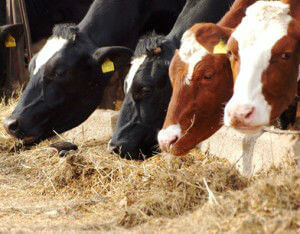
Do you know where your meat comes from? No, not which supermarket, but where it actually comes from? For most, the answer is probably no.
And if you are one of the millions of Americans that shop for what’s on sale rather than what’s of quality, there’s a good chance your steak or pork chops came from an animal raised in a CAFO or confined animal feeding operation. These massive farm operations crowd thousands of animals in cramped quarters and are devastating the environment, the quality of our food and our health.
A Major Pollution Problem
CAFOs dole out over 300 million tons of manure each year. Most operations have poor disposal and storage methods, meaning that most of this animal waste winds up in the soil and groundwater. And, seeing as though most of these animals are treated with any number of drugs, hormones and antibiotics, those same chemicals wind up in the produce we eat and the water we drink.
In rural areas especially, the drinking water is often contaminated and “dead zones,” or areas devoid of marine life due to over-pollution, are a regular occurrence. In fact, most of the land surrounding CAFOs plummets in value as the operations continue to pollute the surrounding area. And those living close by suffer from extra exposure to air pollution thanks to the ammonia byproduct of the excessive manure.
Rising Antibiotic Resistance
Just like children in a classroom, when animals are kept crammed in close quarters, disease often runs rampant. In order to keep bacteria at bay, animals are often treated with high doses of antibiotics regardless of if they’re sick or not.
This leads to the emergence of super-strains of salmonella, E. coli, staphylococcus aureus, otherwise known as MRSA. And yes, these are the same strains that affect humans.
Aside from massive doses of antibiotics, CAFO animals are also treated with a healthy dose of hormones and other drugs that promote rapid growth. In fact, a whopping 70 percent of all antibiotics and related drugs produced in the U.S. are administered to animals used for food production. So every time you consume a treated chicken, you too are administered those same medications.
Diminishing Nutrition
CAFOs work against the natural order of things. For one, they cram thousands of animals on land barely appropriate for a few hundred. This goes against the natural ecosystem of the land, which is often devoid of any nutritious grasses or native plants.
The arid landscape provides an unnatural habitat to the housed animals. Furthermore, these animals are often fed inexpensive soy, grain and corn-based feeds that are not easily digestible or particularly nutritious. The result is meat and dairy products of far inferior quality to that of decades ago.
 What You Can Do To Fight CAFOs
What You Can Do To Fight CAFOs
Search for locally raised meat and dairy products and ask the farmer about his practices.
When shopping in a grocery store, look for phrases like “grass-fed,” “grass-finished” or “no antibiotic use.” And always opt for USDA certified organic meat and dairy products.
Don’t get tricked by terms like “natural” or “cage-free” as they have minimal regulation. Instead look for “certified-humane,” “animal welfare approved,” “American humane certified” or “food alliance” as these labels ensure humane treatment of the animals without the use of any medications.
-The Alternative Daily
Sources:
http://www.cafothebook.org/whatyoucando_4.htm#up
http://www.ucsusa.org/assets/documents/food_and_agriculture/cafo_issue-briefing-low-res.pdf

